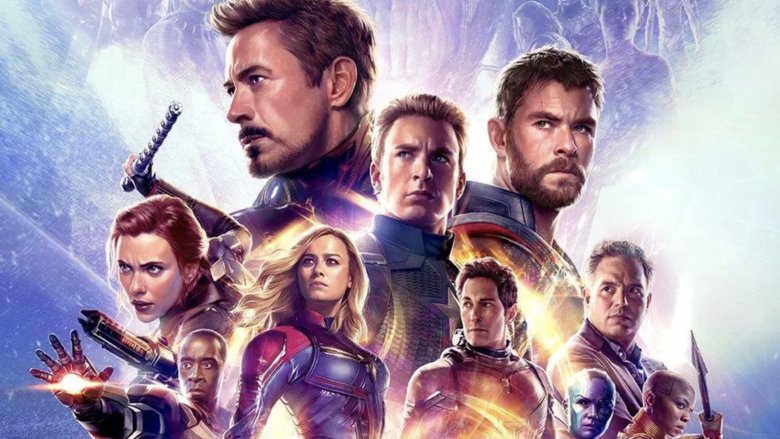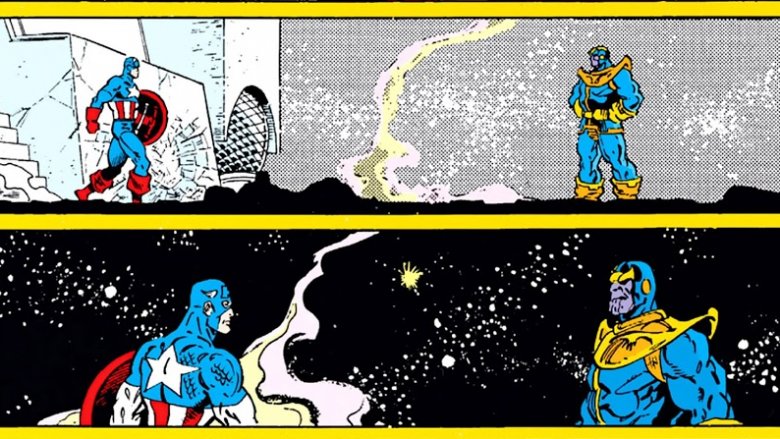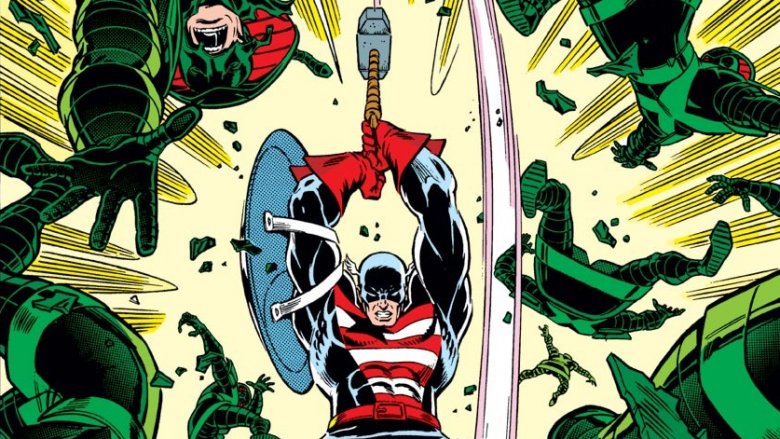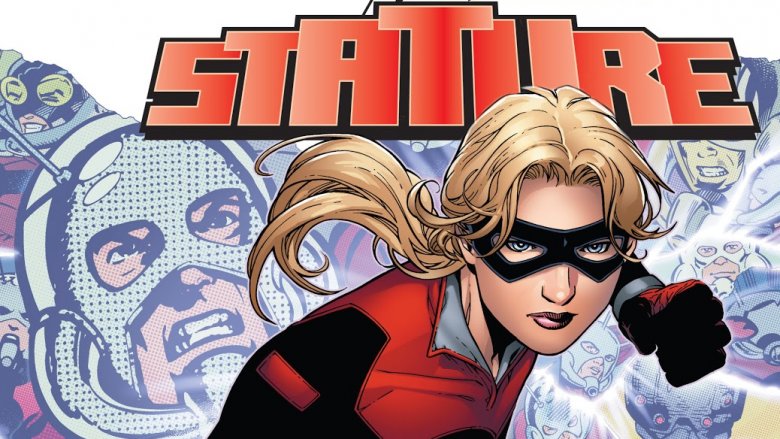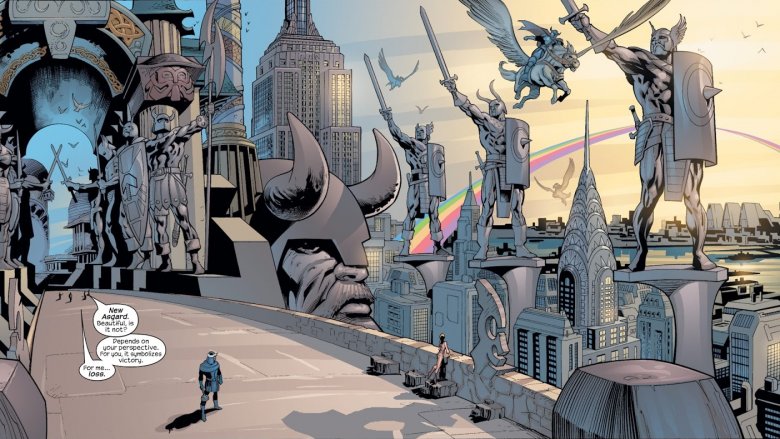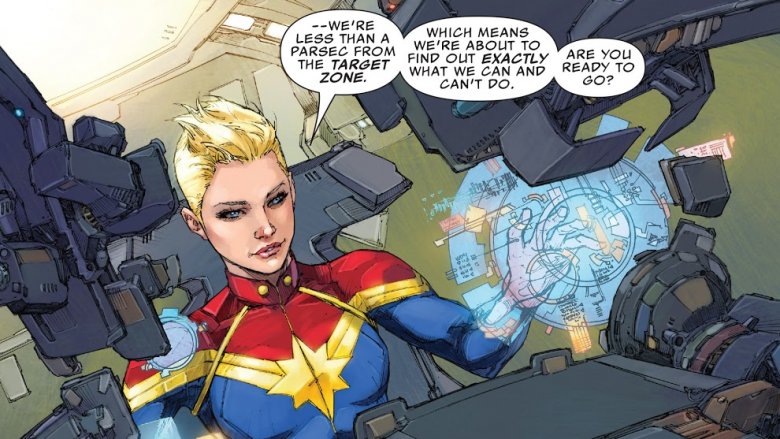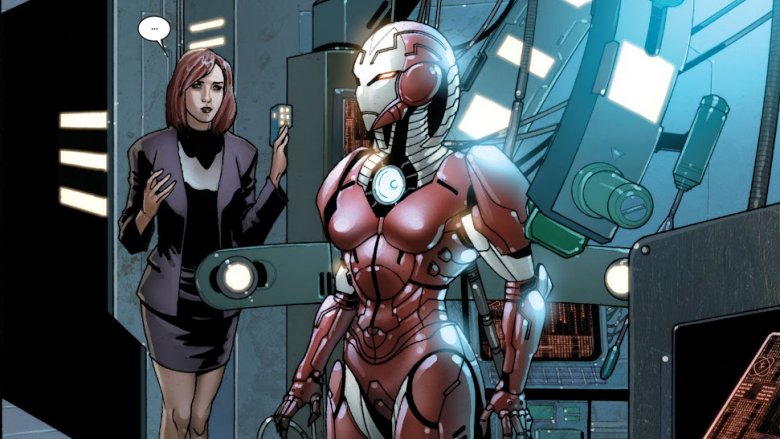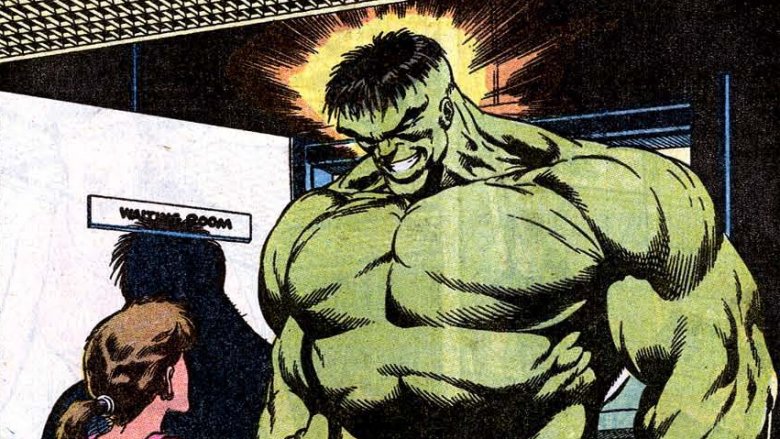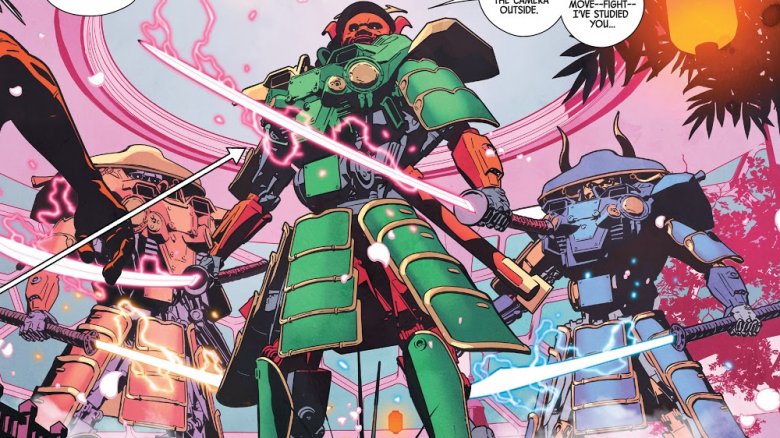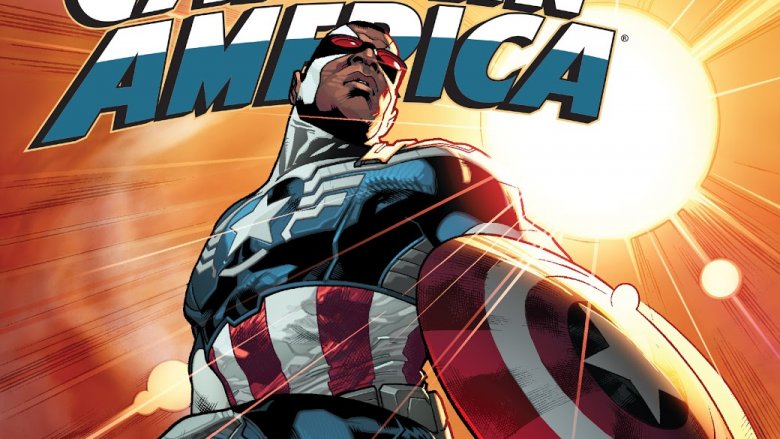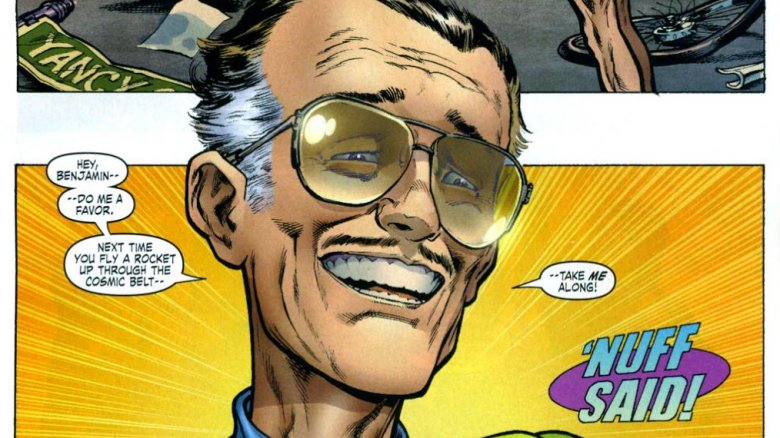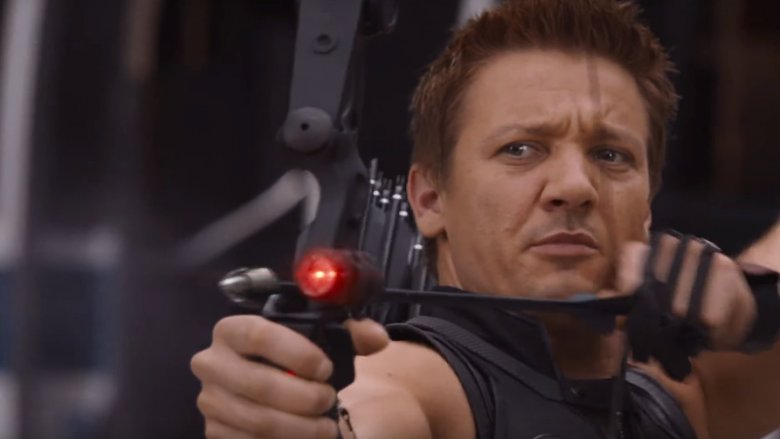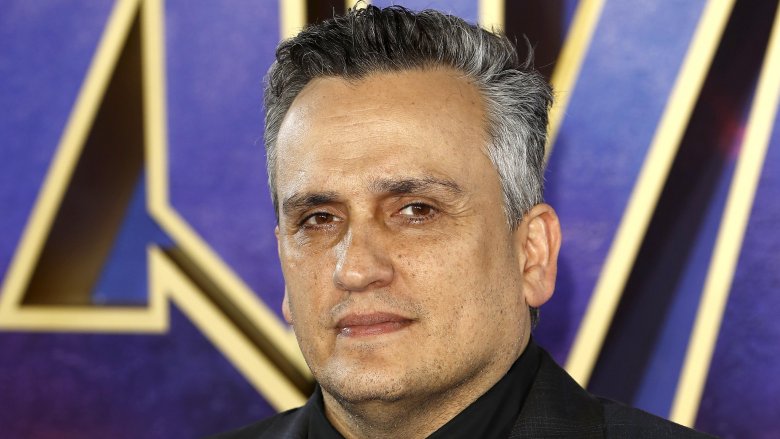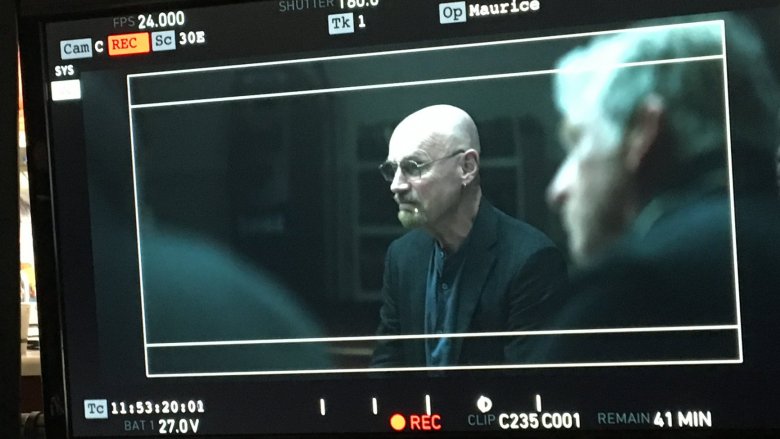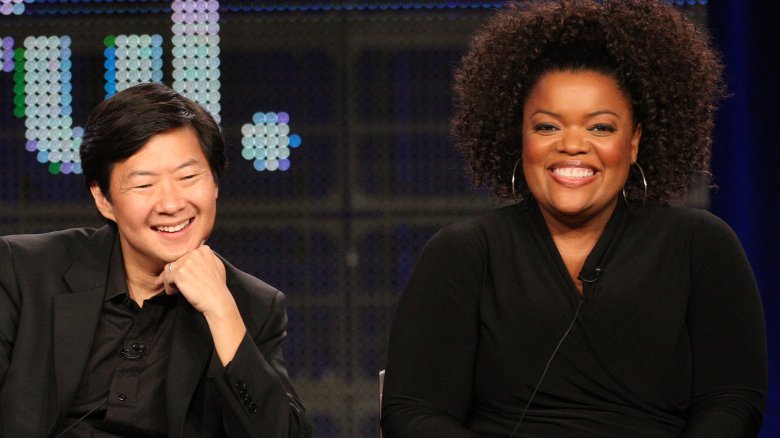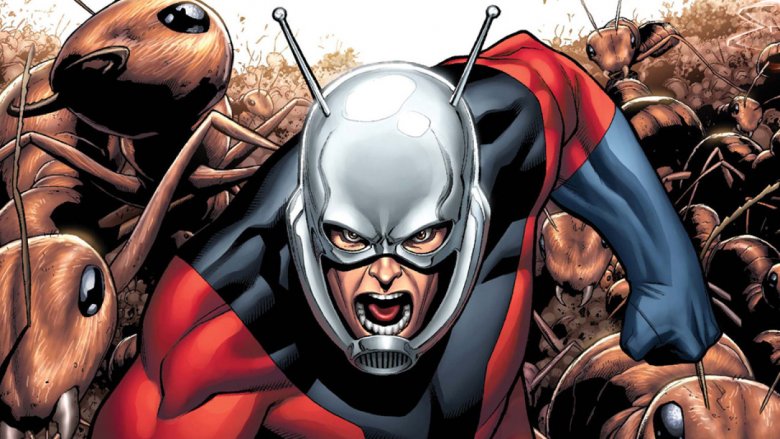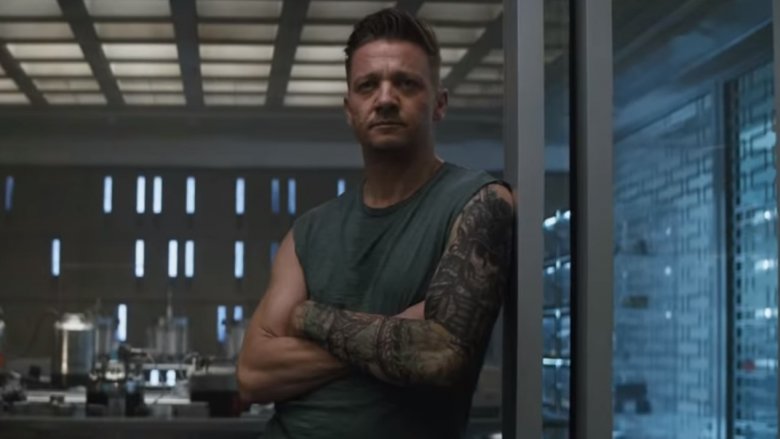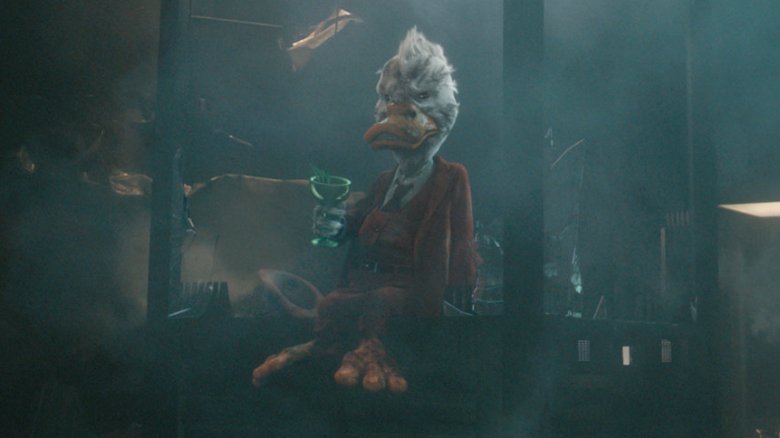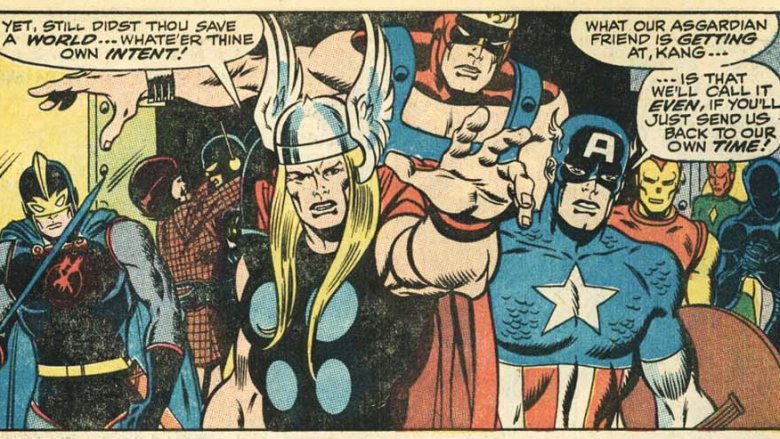Avengers: Endgame Easter Eggs You Missed
As Marvel Studios' film releases built upon each other over the first 11 years of the Marvel Cinematic Universe, the opening tag with the studio's logo went from featuring images of the comics that inspired the films, to a mix of the comics and the films themselves, to just the films. It's indicative of the notion that as the MCU has built its own continuity, many of the callbacks and references have become about the movies themselves, not just their source material. As the grand finale to more than a decade's worth of storytelling, Avengers: Endgame is piled with connections to the movies that preceded it.
Even so, there are still some nuggets tucked away in the movie meant to perk up the eyes and ears of comics fans. So if hearing the words "Avengers Assemble" finally spoken in full on film filled your soul with memories of Avengers comics of yore, then you too may have caught these Easter eggs. Spoilers are, of course, ahead.
Infinity Gauntlet goodies
At the end of the 1991 comics story The Infinity Gauntlet, a soundly defeated Thanos is sent off to an unnamed planet for time out to think about what he's done. The Thanos of Endgame meets a very different end. Twice. But we do find the post-snap Thanos who appears early in the movie similarly situated on a planet without a name — and like the Thanos of Infinity Gauntlet, he's taken up a quiet life of farming, having placed his armor on a stake as a scarecrow of sorts.
Later in the movie, a few more Infinity Gauntlet references pop up. The Avengers-built gauntlet of the movie becomes almost a literal football, with different carriers running it down the field toward Ant-Man's van. In the comic, it also passes between numerous holders, including Nebula, who seizes it from Thanos to take power herself. The two movie Nebulas play both sides of the conflict; the one who ends up holding, but not wearing, the gauntlet is on the Avengers' side.
There's also the moment when Captain America, after Iron Man and Thor are downed, prepares to march up to Thanos alone to face him one on one. Before the cavalry of un-snapped heroes arrives, it's very reminiscent of the comics moment when Captain America stares down Thanos, fully aware he's walking into certain death.
Hammer time
One of the biggest applause moments in the movie comes when Captain America, looking to lend a hand to a downed Thor but needing a little extra oomph, reaches out his hand and summons the Mjolnir Thor retrieved from 2013 Asgard. Yes, Cap is worthy. Thor knew it all along.
Not only has Cap wielding Thor's hammer happened in the comics before, it's actually happened multiple times. It first happens in Thor #390 from 1988, in a story unfolding after Steve Rogers has abandoned the Captain America mantle to simply be the Captain. Thor gets knocked to the ground by a particularly nasty foe named Grog the God-Crusher, dropping his hammer in the process. The Captain goes to retrieve it, and not only picks it up, but takes out a bevy of henchmen in the process. He pretty quickly tosses it back to Thor. In the 2011 event series Fear Itself, Steve Rogers, having taken another sabbatical, takes the Captain America mantle back from Bucky Barnes, who dies (he gets better). Upon Thor's also-apparent death, he lifts the hammer once again to rally the Avengers. And in probably the most controversial instance, the Hydra-allegiant version of Captain America raises the hammer in 2017's Secret Empire.
The moment is also a callback to Avengers: Age of Ultron, when Steve tries to lift Mjolnir but doesn't quite pull it off.
Dads and daughters
Three MCU superheroes have daughters that appear in Endgame, and all of them are direct or indirect versions of characters from comics. The most direct comics connection is Cassie Lang, who appears in Endgame as a teenager, six years older than we last saw her in 2018's Ant-Man and the Wasp. In the comics, she's a teenage superhero who goes by the name Stature and joins the Young Avengers. Like her dad, she can change size, though she tends to opt for the larger side. Scott even remarks to her in the movie, "You're so big!"
In Endgame's opening moments, we see Clint Barton training a young girl, who we find out is his daughter Lila, in archery. A quick glimpse of that scene had some observers thinking the girl might be Kate Bishop, who also goes by Hawkeye in the comics. It makes sense in the MCU for Clint to be training his daughter, who we also saw in Age of Ultron, but one sure nod to Kate is that he calls her "Hawkeye."
And then there's Morgan Stark, Tony's daughter who loves him 3,000. Comics Morgan Stark is very different. He's Tony's cousin, and he believes Tony's dad Howard stole all his ideas from his father Edward Stark, Howard's brother. He teams up with supervillain Count Nefaria to try to kill Tony, and later turns into a giant living robot who wants to turn all plants into metal. He didn't love Tony 3,000.
New Asgard
A lingering question from Avengers: Infinity War was whether any of the Asgardians who were on the ship Thanos attacked at the beginning of the movie survived to resettle on Earth, as they planned to do at the end of Thor: Ragnarok. Endgame lets us know that they thankfully did, building a small but thriving "New Asgard" community in Norway headed up by Valkyrie.
Though there's never been a comics version of Asgard in the Nordic region, there have been a couple times Asgard came to Earth. The version actually called "New Asgard" is from a run of Thor issues from 2003 and 2004 in which an alternate-future Thor has become lord of both Earth and Asgard in the year 2020, and Asgard has been rebuilt over the remains of a devastated New York City. Once that all got reversed, Thor created a version of Asgard on a giant landmass hovering nearby the town of Broxton, Oklahoma for a while in a Thor run that started in 2007.
Sartorial choices
Many of the hair and costume choices in Endgame either point to the passage of time (like Black Widow's blonde/red two-tone hair mix) or dig into the history of the MCU (Captain America wears just about every movie costume except for maybe the ones from Captain America: The First Avenger).
Two character looks are definite nods to comic fans, though. First, there's the red and blue ensemble Rocket wears after the five-year time jump. It's pretty clearly a version of the red-and-blue duds Rocket and the rest of the Guardians of the Galaxy team wore after the mid-2000s Annihilation event, before his comics counterpart started dressing in the orange tones the movie Rocket usually wears. There's also Captain Marvel's new haircut, which Rocket cracks a joke about just after the time jump. It's very similar to the hairstyle Carol Danvers currently sports in the comics, and which she's had since taking up the Captain Marvel name in 2012, after a long history of other superhero identities and longer hair.
Rescue to the rescue
Gwyneth Paltrow's Pepper Potts gets superpowers in Iron Man 3, but she doesn't get a flying armor suit of her own until the final act of Avengers: Endgame. Though she isn't called by the name in the movie, this is undoubtedly the MCU's version of Rescue, the armored identity comics Pepper took up in 2009's Invincible Iron Man #10.
In that story, Pepper is left to her own devices after Tony goes underground, having been publicly blamed for a recent Skrull invasion. With the villainous Norman Osborn as the head of the S.H.I.E.L.D.-like but evil H.A.M.M.E.R. organization, Pepper is tasked with running Stark Industries responsibly. Upon unleashing her fury at Tony by throwing a chair at a wall, she opens up a secret room with the Rescue armor inside and begins her heroic career. In the movie, Tony makes the armor for her willingly — no chair-throwing required.
The professor is in
The Huik's absence in the trailers for Endgame was a very curious thing. Why weren't the Russo brothers and Marvel's marketing department showing us whether he'd be involved in the action? Fans who've seen the movie know now that it was to hide a big reveal: Five years in the future, Banner and the Hulk have figured out a way to coexist as one entity who has the Hulk's size and strength, with Banner's personality and smarts.
It's very similar to the version of the Hulk who would come to be known as "Professor Hulk" and debuted in 1991's Incredible Hulk #377. Though it is worth noting that the movie version is a little friendlier and a little less condescending and openly menacing than the comics version. It doesn't much seem like the comics' Professor Hulk would gingerly pretend to smash things in New York to impersonate his old self. He'd probably smash just as hard, if not harder.
One moment of sizable Hulk strength from the movie comes when he holds up rubble to protect Rocket and Rhodey from being crushed under the debris of Avengers headquarters. That moment has to be an allusion to Secret Wars #4, in which the Hulk (non-Professor) has to hold up the weight of an entire mountain range to save his friends.
That Japanese crime boss
Fans quickly identified Clint Barton's new ruthless assassin persona as Ronin, the masked identity he took up in New Avengers after the Civil War event. (Notably, Clint was not the only, nor the first Ronin. The first was erstwhile assassin and Daredevil love interest Echo.) But who's that crime boss he fights in Tokyo?
His name is Akihiko, and he does have a comics counterpart, though the character's not from too far back in Marvel history. His first (and only) appearance came in 2017's Nick Fury #2, in which he's a member of the Yakuza's Shogun Reapers. Armed with cybernetic shogun armor, he and two other members of the division attempt to attack Nick Fury, but Fury overrides his system and forces him to fight his brothers. Before that can even happen, though, Fury decompresses the room and forces all three to fall to their deaths. Honestly, it's about as quick an appearance as the one made by the movie Akihiko.
Captain America variations
Captain America makes some bold choices at the end of Avengers: Endgame. Instead of popping straight back to the present after returning the Infinity Stones to their rightful places, he chooses to stay in the past to finally have that dance with Peggy Carter. He re-emerges as an old man, having lived a full life, and presents his shield to Falcon to take up his legacy.
Sam Wilson has sidelined his Falcon persona to be Captain America in the comics, too. Starting in 2015, he starred in his own series first called All-New Captain America and later titled Sam Wilson: Captain America. Sam's stint with the shield actually coincided with Steve Rogers having an advanced age, too, though for very different reasons. Comics Steve's aging was the result of a conflict with the villainous Iron Nail, who neutralized his Super Soldier serum. As with everything in comics, he was eventually not old anymore. The movie version seems more permanent.
'Nuff said
Will Endgame's Stan Lee cameo be the late godfather of Marvel Comics' last in the MCU? There may be another one in the can for a future film, but if this is his final one, it's a fitting tribute to the brash and undeniably charismatic figure he cut. And it's nowhere near as much of an emotional ambush as the tribute that preceded Captain Marvel. That was frankly unfair.
Lee's appearance comes when Tony Stark and Steve Rogers are forced to punt and travel back to 1970 for another chance at recovering the Tesseract, which they inadvertently lost in New York in 2012. The world of 1970 comes to life when we see Lee, looking much like he did in the 1970s, driving a muscle car by a military base, shouting at one of the guards there "Make love, not war!" The bumper sticker on his car carries one of his many catchphrases: "'Nuff said!"
Cheeseburgers and Budapest on your left
There's never quite been a movie like Avengers: Endgame. That's probably because there's never been a movie franchise like the Marvel Cinematic Universe. With over 20 interconnected movies released over the span of a decade, Endgame had ample opportunities to make tons of references and callbacks to a sprawling continuity of characters and plot twists. And while many significant lines of dialogue were pretty easy to spot — like "I can do this all day" and "I am Iron Man" — there were still a few fantastic callbacks that might've flown over your head.
For instance, when Natasha Romanoff and Clint Barton flew their spaceship to Vormir to retrieve the Soul Stone, one of them quipped to the other, "we're a long way from Budapest." That refers back to a mysterious mission the two of them went on in their shared past that they referred to during the events of the first Avengers film. Meanwhile, just before the un-dusted heroes all join Cap to fight Thanos and his army toward the end of the film, we hear Falcon jump on the radio to tell his partner, "On your left." That's a callback to when Cap lapped Falcon when the two first met as competing joggers at the beginning of Captain America: The Winter Soldier.
But the most endearing and heartbreaking callback? When Happy Hogan chats with Morgan after her dad's funeral and asks if she's hungry. She says she wants cheeseburgers, and Happy smiles, saying, "Your dad liked cheeseburgers, too." That's a reference back to a scene early on in the very first MCU movie — when Happy and Pepper pick up Tony after his rescue from the Ten Rings, he demands "an American cheeseburger." Like father, like daughter.
Who's that in the support group?
Unless you spend a lot of time watching YouTube videos about the Marvel Cinematic Universe, there's a better than decent chance that you have no idea what Avengers: Endgame directors Joe and Anthony Russo look like. Well, you actually got a great look at one half of the directing duo — you just may not have realized it at the time.
When the movie jumps five years forward in time, we catch up with Steve Rogers in his support group in Queens, New York. In that circle of trust is a man who talks about how he and a date recently spent the whole evening talking and crying. That guy is Joe Russo, the younger of the two brothers who also helmed three other epic MCU entries: Captain America: The Winter Soldier, Captain America: Civil War, and Avengers: Infinity War.
This also wasn't Joe Russo's first time in front of the camera, either. He appeared in an episode of Arrested Development, a show for which he and Anthony directed several episodes, as well as in their film You, Me and Dupree, and all three of their other MCU films — though Joe's part in Infinity War hit the cutting room floor before the movie made it to theaters.
Another guest Star
Joe Russo wasn't the only important person to show up in Endgame's support group scene. While we didn't get a clear look at everyone's faces in the little gathering, we did catch a glimpse of one other person besides Steve Rogers and Joe Russo. Now, comic book fans might know his name, but might not have immediately recognized the face. But believe it or not, that guy was none other than Jim Starlin.
If you didn't know, Jim Starlin is the legendary comics writer and artist who created Thanos — who, if you didn't realize by now, is kind of a big deal in these Avengers movies. He first drew the Mad Titan in Iron Man #55, which also happened to be the first appearance of Drax the Destroyer, yet another character Starlin created.
Starlin shared photos of his time on the set on his official Facebook page on the morning of the film's release on April 26. Considering that guys like Thanos and Drax have been pretty obscure for the vast majority of their existence over the last bunch of decades, it must've been quite the thrill for Starlin to share some screentime with the now beloved characters he created.
Embracing Community
In addition to directing episodes of Arrested Development, the Russos also got behind the lens for several episodes of Dan Harmon's beloved sitcom Community. And that's why two familiar faces from that show — Ken Jeong and Yvette Nicole Brown, who played Ben Chang and Shirley Bennett, respectively — appear over the running time of Endgame.
The first Community cameo we got was Ken Jeong working the security desk at the storage place where Scott Lang was freed from the Quantum Realm. The fun part about Community and his character in particular is that he could totally have been the same one who shows up in Endgame. It's extremely easy to believe that Chang lost his job at Greendale for doing terrible things, then found a sweet gig manning a security desk at an abandoned storage place after the snap. He was even employed as a security guard on the show for a little while... it all makes perfect sense!
On the other hand, don't try to make Shirley living in the MCU a thing. Yvette Nicole Brown's cameo takes place in 1970, specifically in the elevator at the S.H.I.E.L.D. base in New Jersey. Of course, perhaps this S.H.I.E.L.D. agent is a relative of Shirley's — after all, she's the one who narced on Steve and Tony when they infiltrated the base to find the Tesseract. Maybe that's where Shirley got her tendencies to be a total buzzkill.
Familiar headgear
When we caught up with young Hank Pym in the '70s S.H.I.E.L.D. base, we caught a glimpse at his workbench while he spoke on the phone with Steve Rogers. As the camera panned past, there was one distinct looking helmet sitting amid the rest of his stuff that stood out. Longtime comic book fans recognized it immediately as the original helmet Pym used in the comic books to chat with his ant buddies.
Curious about how the helmet works? Lucky you: back in Tales to Astonish #35, where the helmet first appeared, we got a handy dandy diagram explaining all of the helmet's inner workings. While it stands to reason that a real helmet made for talking to ants would need something a lot more sophisticated than "miniaturized electronic equipment," it was still extremely cool to see this important piece of Marvel Comics lore show up on the big screen.
The incredible shrinking arrow-man
Clint Barton's return to the Avengers gave many fans what they'd wanted, as his absence in Infinity War was impossible to ignore while the rest of his teammates fought and lost against Thanos. But Endgame gave Marvel Zombies more than just a return to form for Hawkeye — or Ronin... or whatever he's calling himself these days. The movie also delivered a slyly concealed comic reference that only the most ardent Marvel fans may have noticed.
When Scott Lang is freaking out over doing the time travel test with the last remaining Pym Particles, Barton quickly volunteers to take his place, sleeve tattoo and all. The moment makes a lot of sense for his character, as he's got nothing left to lose by this point, and he's ready to do whatever it takes to try and satisfy the Avengers' mission to restore the world. However, if you've followed Barton's comic book exploits over the years, you'll know that he has a tendency to reach for the Pym Particles when he wants to change things up. In Avengers #63, Barton got fed up with not being able to contribute as much as his superpowered teammates, so he dropped the Hawkeye schtick, drank some Pym Particles, and took the name Goliath. Instead of relying on his superior marksmanship and fighting abilities, Barton... well, Barton got big and smashed stuff.
Howard Stark's butler, and also Howard the Duck
In a movie as gigantic as Avengers: Endgame, it'd be truly impossible to catalogue every single character's appearance — let alone even recognize a fair number of them in the first place.
Case in point: only the most dedicated of Marvel fans may have recognized Howard Stark's butler from Steve and Tony's visit to 1970. But loyal viewers of the late, lamented Agent Carter TV series from 2015 and 2016 would've recognized Edwin Jarvis, played by James D'Arcy both on the small screen and in Endgame. The movie's writing duo of Christopher Markus and Stephen McFeely were executive producers on the show, so they probably had a plan to bring the beloved butler back with this giant MCU swansong for quite a while.
Meanwhile, in a truly blink-and-you'll-miss-it moment, none other than Howard the Duck joined all the heroes during the big battle with Thanos and his army. Keep your eyes trained at the bottom right of the screen when all the resurrected heroes step through Doctor Strange's portals in the third act — specifically when Hope van Dyne and the Ravagers appear. If you pay attention, you'll catch little Howard running onto the battlefield with a gun in his hands.
Believe it or not, this is the third appearance Howard has made in the MCU. He first showed up in the post-credits scene for Guardians of the Galaxy, and then appeared again on the party planet of Contraxia in Guardians of the Galaxy Vol. 2, shortly before Yondu and his crew have a conflict with the other Ravager teams.
The original Avengers: Endgame
The phrase "Endgame" appeared twice in previous Avengers films. The first time came when Tony Stark was defending his reasons for building Ultron, predicting that the arrival of an otherworldly force (like Thanos) would be "the endgame" for Earth. Then, in Infinity War, Doctor Strange echoed Stark's sentiments, saying on Titan, "We're in the endgame now." "Endgame," meanwhile, is a phrase that's commonly used in chess to signify that the game is winding down because there aren't very many pieces left on the board — a pretty accurate summation when it comes to the status of the Earth's heroes when the film starts up.
However, it might not surprise you to know that way, way back in 1969, the 71st issue of the Avengers comic book had a story called "Endgame!" — yes, with an exclamation point. The two stories don't have a ton in common on the surface: the comic book version features characters like the Black Knight and Kang the Conqueror, two guys who have yet to appear in the MCU in any form. But the two stories also have more similarities than you might expect: in the comic book story, the Avengers fight their way through time — sometimes battling once and future members — in order to save the planet. Is it worth rereading some random comic book from the late 1960s to get some better insight into one of the most successful blockbuster movies of the last ten years? Probably not... but the similarities do seem at least a little too close for the name to be a total coincidence.
